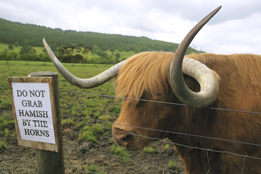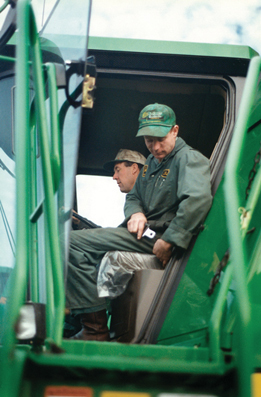Course Orientation
Welcome and Course Expectations

iStockphoto/Thinkstock
Welcome to AGR3000: Agriculture Safety!
In this course you will recognize and assess the hazards and learn about managing the risks of working in an agricultural environment. You will identify community resources that may be available to you to ensure that you develop safety awareness, and learn about ways to ensure your workplace is a safe environment to work in.
Guiding Questions
These questions should guide your thinking and will be explored throughout this course:
- How do I identify and assess hazards in an agricultural area?
- How do I demonstrate standards and practices associated with agricultural health and safety?
- What are my legal rights and responsibilities for agricultural health and safety?
- How do I demonstrate methods for dealing with potential hazards in the agricultural area?
Assessment
Important Components of This Course
This course, AGR3000: Agriculture Safety, is worth one credit and generally takes students between 17 and 25 hours to complete, though that time varies depending on the student.
Course Training Rooms and Projects
This course will be divided into three training rooms. Each training room contains several pages of guiding questions, resources, activities, and assignments intended to focus your thinking on related concepts. Each training room has a main project that allows you to incorporate your learning and connect it to your agricultural worksite.
Agricultural Worksite
It is important that you consider your agricultural worksite as you work through the activities and projects in this course. You will be asked to use your worksite and your experiences there as a resource and reference for your projects and assignments. If you do not have an agricultural worksite, please talk to your teacher about the resources you will use instead.
Course Assessment
- You will be assessed on three projects. Criteria for success and/or a rubric will be provided to guide you. Work through each of the training room sessions of the course carefully. They will assist you in completing the main project assignment for each training room. A portion of your final grade in this course will be based on each of these assignments. You must successfully complete each session and project to receive credit for this course.
- You will also be asked to work on two important self-reflection assignments, one asking you to reflect on your digital citizenship and the other asking you to choose and reflect on personal learning goals for this course.
Student and Teacher Expectations
Student Expections
In order to achieve success in this course, be sure to read all of the instructions carefully and work systematically through the material and related activities. If you have a question, please ask your teacher.
To Do
- Read through the project instructions.
- Set goals for your progress through this course.
- Go through the information and activities in each of the training rooms.
- Complete the project for each training room, including any self- or peer-assessments.
- Submit completed projects and self-assessments to your teacher for evaluation.
Use the Goal Setting Checklist provided at the beginning of each training room to help you keep track of your accomplishments.
Digital Citizenship
Digital citizenship involves being a responsible and participative citizen in your online course. At the end of the course, you will be asked to rate yourself for each of the following categories:
Always |
Sometimes |
Rarely |
|
I am respectful of honesty, trust, and diversity in my work online. I cite sources, only post my own work, and treat my classmates and instructor with respect. |
3 |
2 |
1 |
I work at a consistent pace, and set and meet my deadlines. |
3 |
2 |
1 |
I am an active and enthusiastic participant in my course (participating in discussions, communicating with instructor etc.) |
3 |
2 |
1 |
I adhere to course protocol (posting in the right place, naming files correctly, etc.). |
3 |
2 |
1 |
Project Descriptions
Project 1: Assessment of Potential Hazards in Agricultural Settings
The first training room will help you learn about hazards in the workplace and specifically in agricultural areas.
For your first project, you will need to learn to recognize and assess some agricultural hazards. You will explore the resources provided throughout the training room, case studies of agricultural injuries, and if possible, examination of your actual worksite.
Your project will require you to develop a Health and Safety Hazard Assessment Tool that could identify and alert others to hazards that could cause injuries in an agricultural setting of your choice.
Project 2: Teaching Others About Safety Standards and Practices in Your Agricultural Specialization
The second training room will help you learn about safety standards and practices that help to create a safe agricultural environment.
For your second project, you will focus on safety standards and practices in your agricultural area of specialization. You will demonstrate standards/practices of health and safety that address potential hazards on your worksite by choosing two of the following concerns: fire, electrical use, ladder use, confined space, or chemical handling.
Your project is to teach others how to prevent accidents and injury by creating Risk Management Lessons or Tutorials. You will help others develop awareness of the hazards you have chosen and demonstrate how to use safety standards/practices to improve safety and prevent injuries related to these hazards on your agricultural worksite.
Project 3: Developing an Emergency Action Plan
The third training room will help you learn how to determine methods and equipment used when controlling potential hazards.
For your third project, you will assess hazards and make a plan to control them. Developing a plan to increase awareness of hazards and clearly defining the process for controlling them are both important parts of ensuring health and safety on a farm.
Your project will allow you to create a Health and Safety Action Plan to control hazards on your chosen agricultural worksite.
Learning Outcomes
The Program of Studies for this course details the general and specific learner outcomes that you will achieve by completing AGR3000.
